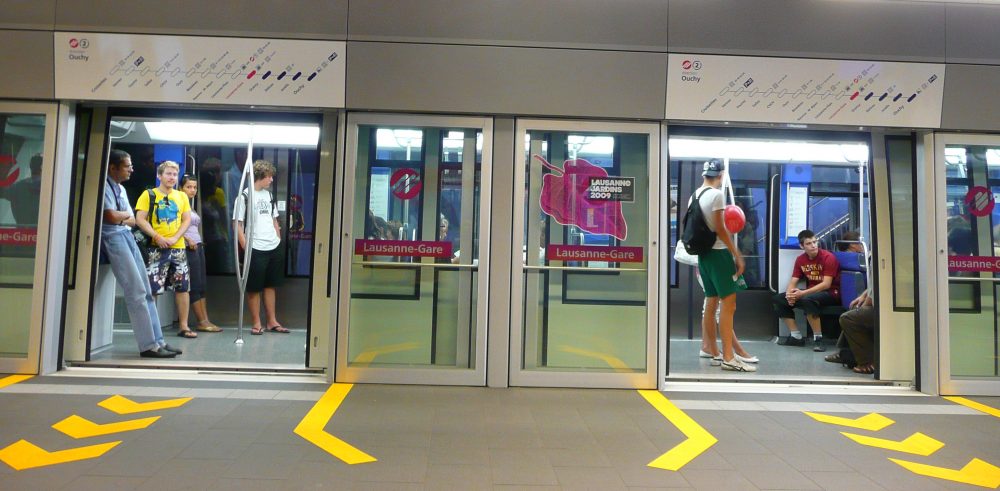Authors: Ruxanda Cornescu and Caroline Voisin
Abstract:
This paper investigates the role of English in bilingual French-English events advertisements in the campus of the University of Lausanne. The campus is regarded as international because of its many foreign students, which makes the use of bilingual advertisements interesting for us to conduct a linguistic landscape research. Our research questions were: 1. How is English used in events advertisements in the University of Lausanne 2. How the type of event advertised influences the French-English relationship, The University of Lausanne being at the same time a French-speaking University, and an international University. We found that English occupied an important position in the different types of events adverts, having different functions: either used as a complement to French because of its modern and ‘trendy’ status, or to give information to foreign people willing to attend events such as conferences.
- Introduction
The city of Lausanne, located in the French-speaking canton of Vaud, Switzerland, home of the International Olympic Committee (IOC), is quite an international city. And it is not surprise that its University, located at the shores of Lake Geneva, has the reputation to be a place where around 120 different nationalities meet. Indeed, if the school is attended by about 14’900 students, 23% of them are international students, coming mostly from European countries (France, Italy, UE countries), but also from America (both North and South) Africa and Asia (UNIL website, 2017). This diversity results in a cohabitation of different cultures, that constantly come in contact in the University’s campus. Associations, sports clubs and events in the campus lead to a contact of the different cultures, as exchange students are usually interacting with Swiss/local students. Moreover, the different associations represent differences of culture: it is the case, for example, of the associations representing Muslim students, Christian students, Tessin students, or for the rights of people in exile. All in all, a hundred associations exist and, among them, several focus mainly on event organisations. Regarding the international construction of the University of Lausanne, we decided to look at the use of English in the advertising of events taking place within the campus, including conferences and concerts, among others. By means of linguistic landscaping, we aim to see how English is used in advertising events in the University context, and how it interacts with French, English being used as the language of international communication. (Piller: 2006) The signs we collected pictures of are from various sources, with different types of events advertised. This paper will thus try to answer the following research questions: how is English used in event advertisements in the UNIL campus? What is its role alongside French depending on the type of event?
This paper will first introduce the subject of English in bilingual advertising, with regard to previous researches on the use of English in (bilingual and non-bilingual) advertisements, before providing information on the chosen area of study. Next, we will give details on our methodology of linguistic landscaping to conduct our research, and finish by presenting our results and discussing them in connection to the previous studies on the subject. Lastly, a conclusion will close our paper.
- Theoretical framework
Advertising discourse is regarded as a well-known subject among the applied linguistics field, whereas language contact has partly missed out from the researches’ front stage (Piller, 2003, page 170). According to the author, advertising is a site of language contact that needs to be explored, especially the role of English: indeed, it differs between English-speaking markets and non-English-speaking markets (Piller, 2003, page 4). English is a popular advertising technique, in the way that the globalization of English happened in multilingual fields, because it had become a marketing strategy for advertisement around the globe (Kuppens, 2009). Therefore, it explains why English might be a logical choice as a larger marketing strategy. Moreover, the author argues that another reason for the choice of English in advertisement is due to “creative-linguistics reasons”, as well as “cultural connotations” (Kuppens, 2009, page 116) Indeed, English is often used to replace foreign words with equivalents, either because it fits better or because it draws the reader’s attention more easily (Kuppens, 2009, page 116). It seems then that, more than being the dominant language around the world, English also has quite a mode-ish usage (meaning it is stylish), as mass medias helped spread American culture around the world, especially in Europe. In both Piller’s and Kuppens’ work, English is connected to several social stereotypes: modernity, youth, cosmopolitanism, internationality. Moreover, regarding the media, Kuppens adds that English is used in advertisements because it is the language of genres that are part of global mass (consumer) culture (Kuppens, 2009, page 131). In that sense, English is regarded to be a ‘transparent language’ that belongs to (and is reachable by) everyone. Altogether, those qualities explain why English is often used in bilingual/multilingual advertisements around the world.
The bilingual French-English audience draws a lot of new challenges to the advertising companies: how to draw the attention of a local audience with an international language? “When individuals direct their attention to the code-switched word, they will activate the language schema to which that word belongs and become aware of the social meaning carried by the language” (Luna et al, 2005, page 161). According to the authors, code-switched messages is a strategy to influence bilingual individuals, including customers, which brings us to the importance of code-switching in advertisement. Indeed, some words are activated on purpose, as English words symbolize modernity, and even a trend. Horniks (Horniks et al, 2010) conducted a study in the Netherlands on that base, arguing that little is known about people’s preference for English over the local language By investigating how the level of difficulty of English on adverts broadcast in the Netherlands impacted on the local population’s understanding of the ads, the authors came to the conclusion that a foreign language does not necessarily need to be understood: what really matters is that such language represents a symbol. Therefore, the understanding of the foreign language (in that case, English) does not matter, but the appreciation increases the public understanding, and consists in a way of persuading the audience. On that matter, a group of Spanish linguists draws our attention on the fact that texts are organizing the discourse, can engage the audience and signal the writer’s attitude: in that way, language is used to achieve specific purposes (Fuertes-Oliveira et al, 2001). Print advertising therefore is one domain where the orientation toward the reader is crucial. That way, and even in our data, it is important to remember that English words are there for a reason, and therefore it is important to analyse them closely. Unfortunately, we were not able to find precise researches on events advertising, probably because it is a quite recent field, therefore not yet completely in linguistic researchers’ interests.
- Contextualisation
The city of Lausanne, capital and biggest city of the canton of Vaud, is located by the lake of Geneva, natural border with France. Lausanne, by hosting the International Olympic Committee, just became the focus of international sports, bringing the title of “Olympic Capital” to the city’s prestige. In addition, the headquarters of the Court of Arbitration for Sport (CAS) and around fifty international sports associations. All those institutions are attracting an international audience and foreign tourists to Lausanne, making English a common language heard in the city, as well as the current lingua franca (Durham, 2016)
The University of Lausanne was created in 1507, as a theological protestant school, the only French-speaking of its type, thus well-known both locally and internationally. The teachings provided by the school started diversifying, until reaching the status of University in 1890. In 1909, R.A. Reiss created the first school of forensic science in the world, ranked number two nowadays, behind FSU in Florida, USA. Around 1970, the University moved from the old city of Lausanne (near the cathedral and castle) to its current location, Dorigny. This is relevant because the prestige of some faculties, such as the Criminology School mentioned above, contributed in attracting more foreign students (UNIL website, 2017). Indeed, the University not only has 1/5 foreign students among its ranks, but also has 1/3 of teachers that comes from diverse countries, which denotes of the international atmosphere that the University itself likes to bring up as a sign of prestige and validation (UNIL website, 2017). The students attending campus are from various social and ethnical backgrounds, therefore it is impossible to establish regular patterns. More recently, the University has partnered with EPFL, also a world-class and internationally-known school, to form two big campuses next to each other, attracting even more foreign students. Also, new faculties were created, mostly concerning the Human and the Living (biology and medicine), attracting even more students to come and study in Lausanne. The students are forming a community in the University, mixing cultures and languages – putting English forward as a mean of communication between foreign students and locals, just as locals do when they don’t come from the same language part from Switzerland (Durham, 2016)
- Methodology
During the month of October 2018, we started paying attention to event advertisements displayed around campus, in the different buildings. Having our courses mainly in Géopolis and Anthropole, we essentially collected most of our data in those two buildings, later mixing up data from Internef, Amphimax/Amphipôle, and from the campus’ library (the ‘Banana’). We collected a total of fifteen pictures, focusing on signs advertising events only, with English and another language on them (all multilingual then). The events mostly were cultural, and concerned extra-scholar matters, such as concerts or parties, but they also were scholarly events, such as conferences. Therefore, the events advertised were top-down, as an association or institution were organizing it, and that the students (and sometimes teachers) were the targeted audience. We collected the data within two weeks, each on our own, before coming together in order to compare what we had collected. It appeared to us that our data were quite similar – even though the pictures were never identical – and that most of them were a mix of French and English. From that point on, we decided to focus on ads that had those two languages on them. Finally, we reduced the pictures collected to a set of 10 pictures to analyse, according to a criterion of relevance.
Both of us were very familiar with the field chosen – being both students at the University of Lausanne, with Social Sciences and English cursus – which means it was not difficult for us to collect the pictures. Furthermore, being familiar with the events taking place on campus – especially parties and conferences – we had come across similar types of ad, therefore the idea of working on that kind of advertising was almost evident. When we started collecting the data, we expected to find more types of languages in the advertisement ads, but we mostly came across French-English advertisements – the rest were in Italian (because it targeted Tessin students) or other languages less commonly spoken in the University of Lausanne, such as Japanese for instance. Consequently, we focused on the ads containing both French and English – which were not hard to find. What was trickier, on the other hand, was to choose the signs we wanted to analyse and reduce the data to 10 pictures.
- Results
In order to conduct our research on the use of English on events advertisements in the University of Lausanne, we took a total of ten pictures in the area of UNIL, represented by the grey pins (illustration 1). Out of the ten observed signs, all of them were bilingual English and French. Furthermore, as all of the signs were advertisements, they were all commercial. They were all commercial and produced bottom-up from different groups belonging to UNIL; however they were not all for profit. We were able to find different types of events being advertised such as concerts, conferences, exhibitions, a party or movie screening. Some events
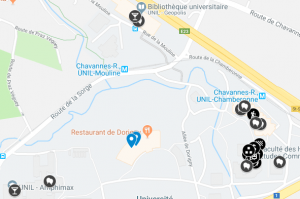
Illustration 1
After analysing all of our data, as the advertisements contain only French and English, we decided to divide them in two groups: the leisure versus the academic events because the public that is being addressed will differ in the two groups.
We found that English is always present in the titles of the leisure events such as concerts, movie screening or parties because the addressee differs from the academic events, mostly targeting younger people: to do so, using creative techniques or taking advantage of English connotations are two strategies used to draw the addressees’ attention, these will be seen more in details when analysing the different advertisements. English’s role can be seen as more ‘persuasive’, using strategies to draw attention on the advertisement: this is the symbolic function of English. On the other hand, concerning the more intellectual events, English was not used in to ‘’attract’, but’ more to set the target people who could be interested in them, there is a more informative/practical use of English. Furthermore, we found that English and French coexistence differs whether it is on an entertaining or academic ad. There is a tendency of English being used as a primary language on the leisure advertisements and on the contrary French is being used primarily on the academic ones.
We will start by analysing the leisure events advertised in our data and try and give a first approach to the techniques used to persuade the public:
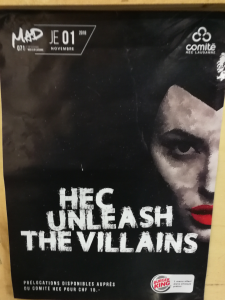
Picture 1.
In this advertisement English is the Primary language for several reasons; first of all the party is organised by the HEC committee and the advertisement was found in Internef, which is known for its international students (both in HEC and Law faculties) and usual use of English, as the HEC students have most of their courses in English, being quite a cosmopolite population (it is a world famous Business school, so there are many international students). There is here an intergeneric intertextual intent, ‘’the meaning and/or humour of these ads can only be understood and appreciated if viewers are familiar with what the text is referring to’’ (Kuppens, 2009). In that case, the reference is to Disney’s 13, which makes sense given to the fact that the ad advertises a Halloween party. The HEC also chose English instead of French because of its connotations (fun, young, cosmopolitan), so the prestige of the language is taken advantage of here as well. Furthermore, the fact that Disney is a well-known company of very famous child movies (such as the Lion King for instance) allow the readers of the advert to recognize a shared knowledge, and their attention being caught by a centre of interest; there is here a link between English and American cultural references (Kuppens, 2009)
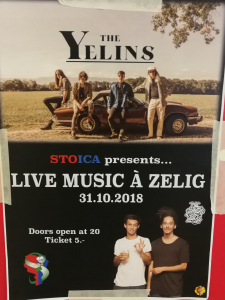
Picture 2.
This ad is also multilingual, with English as its primary language. It is an advertisement for a concert that will take place at Zelig, in the Géopolis building – Zelig being the University’s bar, more specifically of the SSP faculty (Psychology, Social Sciences, Political Sciences and Sports. Géopolis is known for its international public but it is still nonetheless part of a French-speaking university. The concert is organized by STOICA, which is an Italian student association. The reason why English is used is because of the fact that more people understand English than Italian, and they would not want their party to be attended only by Italian-speaking students but extend their potential public to all students. Therefore, the use of English as well as French allows them to attract a wider public and serve here as a lingua-franca. This can explain the domination of English on other languages (i.e. Italian), with an exception for the French ‘’à’’ to indicate where the concert will take place which can be because of the French speaking University and the existing debate between the uses of ‘’à’’ or ‘’au Zelig’’ to say ‘’At Zelig’’. In this case, they seem to indicate their position in the debate which adds a touch of irony to the advertising. This nudge to the debate also serves as a technique to engage exchange with the addressee who will understand what the advert is alluding to. The English ‘’Live Music’’ as part of its title can be creative, as it is more attractive than the French ‘’musique en direct’’, sounding more modern and more representative of the young public. The prestige use resides in English’s connotations of modernity and youth as Zelig’s main customers are for the most part students, and sometimes alumni or even teachers. There can be a last observation made with picture 3, even if the whole advertisement is mostly in English, for advertising purposes, consumers do not even need to understand the foreign language that is used to appreciate it, however the appreciation increases when they fully understand the content; in our case, if the person does not speak English, he/she can easily understand as ‘’live’’ is already a common word in French, music is very similar and Zelig is known by people at UNIL.
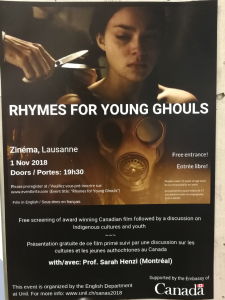

Picture 3. Picture 4.
The English title in the Picture 4 can be explained by the fact that English is used in a creative manner: English can be used when a word is better suited than the local language version of it because it is more attractive (Kuppens, 2009). Here it is the case for the ‘’Jam’’, a common word (both in French and English) meaning a music playing session. The concert takes place in the ‘’Banane’’, UNIL’s library. If they were to associate the French word ‘’banane’’, it would not have been understandable that jam was English, thus there is a word invention ‘’Bananajam’’, a common practice aiming to place nonsensical words that sound English to activate certain values with the consumers (Kuppens, 2009). Concerning Picture 3, the title is the name of the movie that will be screened; it is a Canadian movie and will be in its original version, English. This screening is organized by the English department of UNIL and supported by the embassy of Canada; all of these facts can serve to explain why the primary language is English on this advertisement. However, there is a translation of every line in French; even though the movie is in English it will be subtitled in French so people who cannot speak English can still attend the event: this explains the French presence on the advertisement. Another explanation can be that UNIL is a French-speaking University so there is a will to make everyone understand the ad. After analysing the leisure events, we found that English was put forward for practical matters (place, time, price of the events) but also for its prestige, symbolic values and creativity techniques because the public targeted was a younger one.
Concerning the more academic events, we also found some advertisements that were all multilingual; We will start by analysing the use of English in them:
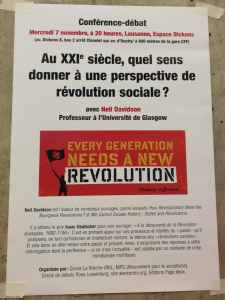
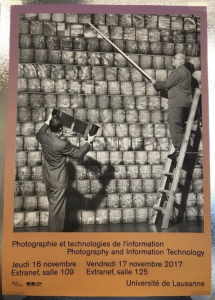
Picture 5. Picture 6.
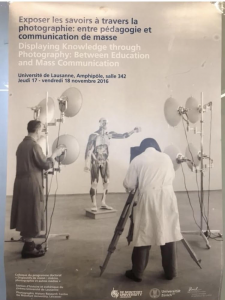
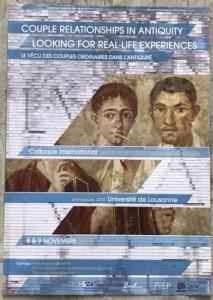
Picture 7. Picture 8.
When analysing these 4 advertisements, we can see that Picture 6 is a photography exhibition: both English and French are present on the ad in order to attract a larger public possible since the event is based on observing photographs. Pictures 5, 7 and 8 are all conferences. On picture 5, there is an image with an English message. This ad references a conference to be given by a guest professor from the University of Glasgow (English-speaking), therefore it seems that the image containing the quote ‘’ Every generation needs a new revolution’’ on the ad is meant to reference his origins. Furthermore, the quote is from Thomas Jefferson, also native English speaker, so it is edited in the original version, probably to keep up a sort of authenticity. On Picture 7, the primary language is French because it is in UNIL, which is a French speaking university. Only the title is translated in English because it will attract a bigger public to this seminar which will be both in French and English. In Picture 8 the primary is English because it is the language of the main title and it is the first thing seen by people. This can be explained by the fact that it is mentioned that it is an international conference that will be given in French and English. By putting an English title, it will attract the attention of a larger public, the addressee here is a well educated person interested in antiquity topics.
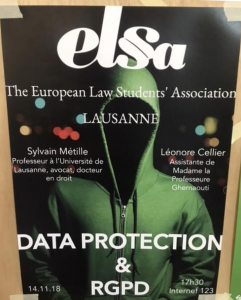
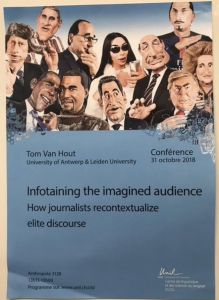
Picture 9. Picture 10.
Both events are multilingual with English as their primary language. English on picture 9 can be explained by the fact that the conference will be in English; the reason is that it is organized by the ”European Law students’’ association” which reunites students from many languages and English here serves as the communication language between many nations (Lingua Franca). It is important to notice that this event will be held in the Internef building, where the (reputed) Law school of UNIL is. In French we can find more practical information, such as, for example, the participating teachers. Picture 10 is an advert for a conference that will be given in English which can explain that we find mainly English on the advert, however the word ‘’conférence’’ and practical information is given in French. We can therefore see here that English is used in order to target more people who could understand it and practical matters are written in French due to the French speaking nature of the University and its French-speaking region.
- Discussion
As previous researches have shown (Piller, 2003; Kuppens, 2009; Horniks et al., 2010 ; Martin, 1998), English is widely used for advertising in areas that are not English-speaking, and this was true for UNIL as well. English was used in all our events, but it depends on the type of event (leisure or academic) its use varied. As Hornikx argues, ‘’comprehension of English does not matter, a foreign language is considered as a symbol for which the understanding does not matter but the appreciation increases when the public understands’’ (Horniks et al.., 2010). The entertaining group of advertisements tend to use English with a persuasive, commercial approach as they use it for its connotations (youth, fun, international, cosmopolitan), as put forth by Kuppens, ‘’As per the connotations of the English language, Indeed, several studies report that for advertising purposes, consumers need not even understand the foreign language that is used, as long as they recognize the connotations that it is associated with’’ (Kuppens, 2009). There are also different creative techniques to persuade the targeted public as put forward by Kuppens ‘’Some other noticed practices are to even use ‘invented’ or ‘nonsensical’ English in advertisements, i.e. meaningless words or sentences that only sound English—and can thus activate certain values with the consumers.’’ (Kuppens, 2009). The last usage of English in a creative way as seen in Kuppens’ study is to refer to another text or to an idea in order to create an exchange with the consumer ‘’intra or intergeneric intertextual intent, the meaning and/or humour of these ads can only be understood and appreciated if viewers are familiar with what the text is referring to. (Kuppens, 2009). These techniques can be seen in the HEC advert or the Zelig concert for example. As per the more academic events advertisements, the use of English is more informative and practical as it consists in translations and practical information in order to attract (with no use of any creative technique) people who could understand the content of the event (all of the intellectual events are partly in English). The fact that there is no creative use of English could be because they target an older public as language play is associated with youth. This answers the first part of our research question which is how English is used in event advertisements at UNIL. For the second part of our research question regarding the coexistence of both English and French on the advertisements we also found differences depending on the type of event that was advertised. Regarding the entertaining type of adverts, English was the primary language on most of them and French was used for more practical information which can be explained by the fact that UNIL is a French-speaking university and in a Francophone region. This observation is also explained by the fact that English is used in a symbolic way, to attract people’s attention thus making French secondary. Concerning the more intellectual types of events, we can observe the contrary; French tends to be the primary language on most of them and English serves as translation; we can see here that there is no advertising strategy behind the use of English because of the age of the targeted public which tends to be higher in this case. It can also be explained by the fact that all of these events are part English, there is the will to attract both people that understand French or English but putting French forward because of the University’s main language. A last observation can be made on our events advertisements which is that English was used as a primary language in 100% of the ads that were advertised by an international organization which in a way confirms the international connotation of English that is fun, young, cosmopolitan etc…
- Conclusion
This study has several limitations, one of them being the lack of information of the addressee’s perception of these advertisements. We have evidence in our theoretical framework that English is used in many ads all over the world and the understanding of it does not matter in order to have an impact on the consumer. It would have been useful for our study to interview different people and see how they viewed the advertisements for example or to have some perception data in order to measure which of the two types has more impact depending on the age of the addressee since we noticed that the entertaining ones are targeting younger people and vice versa. Furthermore, we decided to only focus on English-French events adverts but it would have been very interesting to analyse advertisements that contained other languages as well and try to understand the reasons behind such practices as well as maybe analysing other types of adverts than events. It could thus be of interest for future research to see if and how other foreign languages are used in UNIL events advertisements as well other ones as sales at the local book shop or travel agency for example. Nonetheless, our study showed that English was used in a variety of different advertisements and that it varied on the type of public that it targeted. As put forth by Horniks et al., “English serves as the lingua-franca especially in countries like Switzerland where we have a complex multi-lingual landscape.” (Horniks et al., 2010), which is truly visible in UNIL where the English language is very present in the public space in a variety of ways and as we have noticed it in our case, events advertisements. While some of our multilingual ads used English for creative matters, other ads used it for more practical reasons as the place, time of the event etc… Thus, even in our small-scale study we could nonetheless observe the multi-functionality of the English language in this otherwise Francophone university.
Bibliography
Durham, M. (2016). English as a lingua Franca: forms and features in a Swiss context. Cahiers de l’Institut de Linguistique et des Sciences du Language, 48, 107-118.
Fuertes-Oliveira, P. Velasco-Sacristan, M. Arribas-Bano, A. Samaniego-Fernandez, E. (2001). Persuasion and advertising English: Metadiscourse in slogans and headlines. Journal of Pragmatics, 33, 1291-1307.
Horniks, J. van Meurs, F. de Boer, A. (2010). English of a Local Language in advertising? The Appreciation of Easy and Difficult English Slogans in the Netherlands. Journal of Business Communication, 47(2), 169-188.
Kuppens, H. (2009). English in Advertising: Generic Intertextuality in a Globalizing Media Environment. Applied Linguistics, 31(1), 115-135.
Luna, D. Peracchio, L. (2005). Advertising to Bilingual Consumers: The Impact of Code-Switching on Persuasion. Journal of Consumer Research, 31, 760-765.
Martin, E. (1998). The use of English in written French advertising: a study of code-switching, code-mixing and borrowing in a commercial context. Studies in the Linguistic Sciences, 28(1), 159-184.
Martin, E. (2002). Mixing English in French advertising. World Englishes, 21(3), 375-402.
Piller, I. (2001). Identity constructions in multilingual advertising. Language in Society, 30, 153-186.
Piller, I. (2003). Advertising as a Site of Language Contact. Annual Review of Applied Linguistics, 23, 170-183.
Websites
Official Website of the University of Lausanne. Available on: https://www.unil.ch/central/en/home.html. Accessed on the 15.12.2018.
Official Website of the City of Lausanne. Available on: http://www.lausanne.ch/fr/. Accessed on the 16.12.2018.
Official Website of EPFL (Ecole Polytechnique Fédérale de Lausanne). Available on: https://www.epfl.ch/en/home/. Accessed on the 16.12.2018.
